Description of the clinical situation
VerifiedAdded on 2022/09/09
|7
|1691
|15
AI Summary
Contribute Materials
Your contribution can guide someone’s learning journey. Share your
documents today.
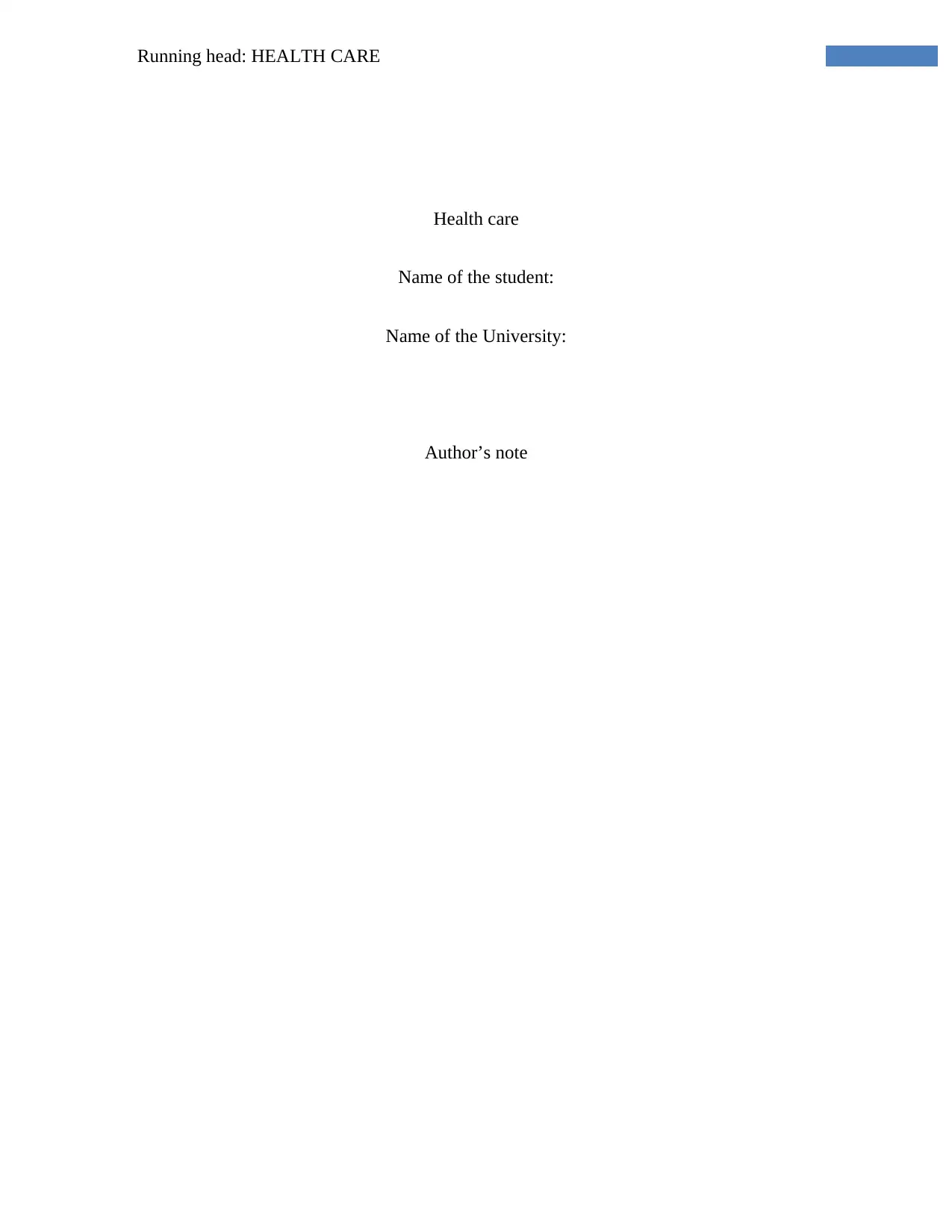
Running head: HEALTH CARE
Health care
Name of the student:
Name of the University:
Author’s note
Health care
Name of the student:
Name of the University:
Author’s note
Secure Best Marks with AI Grader
Need help grading? Try our AI Grader for instant feedback on your assignments.
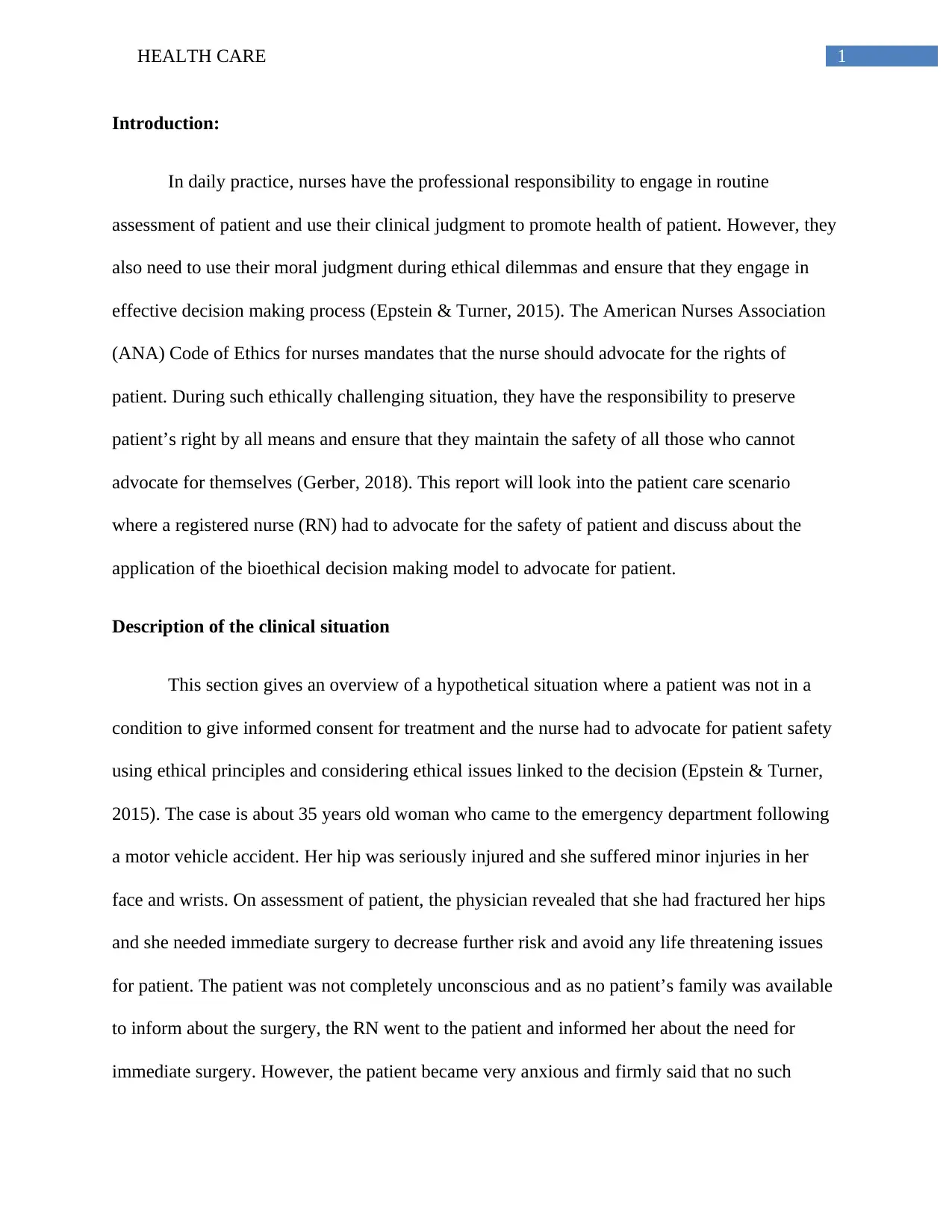
1HEALTH CARE
Introduction:
In daily practice, nurses have the professional responsibility to engage in routine
assessment of patient and use their clinical judgment to promote health of patient. However, they
also need to use their moral judgment during ethical dilemmas and ensure that they engage in
effective decision making process (Epstein & Turner, 2015). The American Nurses Association
(ANA) Code of Ethics for nurses mandates that the nurse should advocate for the rights of
patient. During such ethically challenging situation, they have the responsibility to preserve
patient’s right by all means and ensure that they maintain the safety of all those who cannot
advocate for themselves (Gerber, 2018). This report will look into the patient care scenario
where a registered nurse (RN) had to advocate for the safety of patient and discuss about the
application of the bioethical decision making model to advocate for patient.
Description of the clinical situation
This section gives an overview of a hypothetical situation where a patient was not in a
condition to give informed consent for treatment and the nurse had to advocate for patient safety
using ethical principles and considering ethical issues linked to the decision (Epstein & Turner,
2015). The case is about 35 years old woman who came to the emergency department following
a motor vehicle accident. Her hip was seriously injured and she suffered minor injuries in her
face and wrists. On assessment of patient, the physician revealed that she had fractured her hips
and she needed immediate surgery to decrease further risk and avoid any life threatening issues
for patient. The patient was not completely unconscious and as no patient’s family was available
to inform about the surgery, the RN went to the patient and informed her about the need for
immediate surgery. However, the patient became very anxious and firmly said that no such
Introduction:
In daily practice, nurses have the professional responsibility to engage in routine
assessment of patient and use their clinical judgment to promote health of patient. However, they
also need to use their moral judgment during ethical dilemmas and ensure that they engage in
effective decision making process (Epstein & Turner, 2015). The American Nurses Association
(ANA) Code of Ethics for nurses mandates that the nurse should advocate for the rights of
patient. During such ethically challenging situation, they have the responsibility to preserve
patient’s right by all means and ensure that they maintain the safety of all those who cannot
advocate for themselves (Gerber, 2018). This report will look into the patient care scenario
where a registered nurse (RN) had to advocate for the safety of patient and discuss about the
application of the bioethical decision making model to advocate for patient.
Description of the clinical situation
This section gives an overview of a hypothetical situation where a patient was not in a
condition to give informed consent for treatment and the nurse had to advocate for patient safety
using ethical principles and considering ethical issues linked to the decision (Epstein & Turner,
2015). The case is about 35 years old woman who came to the emergency department following
a motor vehicle accident. Her hip was seriously injured and she suffered minor injuries in her
face and wrists. On assessment of patient, the physician revealed that she had fractured her hips
and she needed immediate surgery to decrease further risk and avoid any life threatening issues
for patient. The patient was not completely unconscious and as no patient’s family was available
to inform about the surgery, the RN went to the patient and informed her about the need for
immediate surgery. However, the patient became very anxious and firmly said that no such
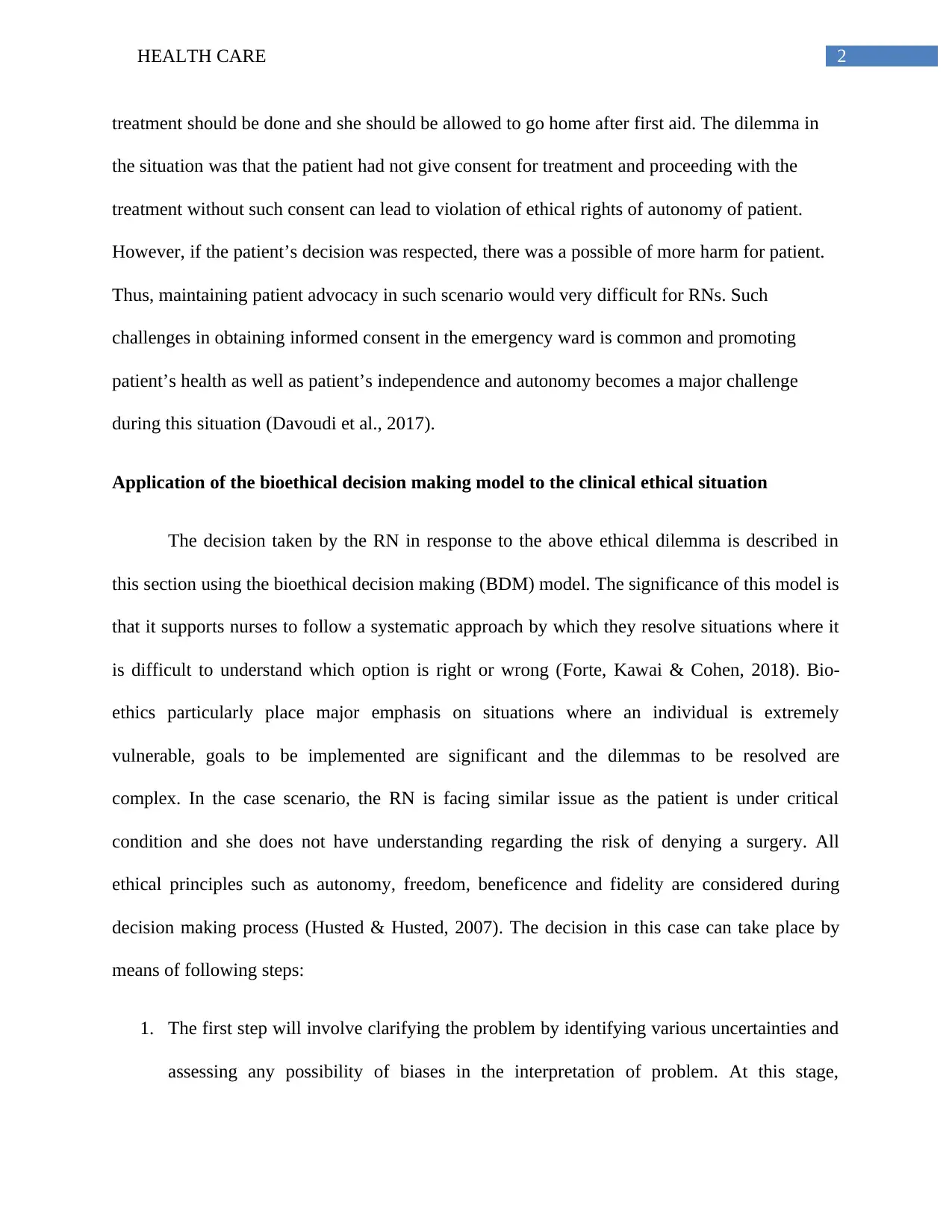
2HEALTH CARE
treatment should be done and she should be allowed to go home after first aid. The dilemma in
the situation was that the patient had not give consent for treatment and proceeding with the
treatment without such consent can lead to violation of ethical rights of autonomy of patient.
However, if the patient’s decision was respected, there was a possible of more harm for patient.
Thus, maintaining patient advocacy in such scenario would very difficult for RNs. Such
challenges in obtaining informed consent in the emergency ward is common and promoting
patient’s health as well as patient’s independence and autonomy becomes a major challenge
during this situation (Davoudi et al., 2017).
Application of the bioethical decision making model to the clinical ethical situation
The decision taken by the RN in response to the above ethical dilemma is described in
this section using the bioethical decision making (BDM) model. The significance of this model is
that it supports nurses to follow a systematic approach by which they resolve situations where it
is difficult to understand which option is right or wrong (Forte, Kawai & Cohen, 2018). Bio-
ethics particularly place major emphasis on situations where an individual is extremely
vulnerable, goals to be implemented are significant and the dilemmas to be resolved are
complex. In the case scenario, the RN is facing similar issue as the patient is under critical
condition and she does not have understanding regarding the risk of denying a surgery. All
ethical principles such as autonomy, freedom, beneficence and fidelity are considered during
decision making process (Husted & Husted, 2007). The decision in this case can take place by
means of following steps:
1. The first step will involve clarifying the problem by identifying various uncertainties and
assessing any possibility of biases in the interpretation of problem. At this stage,
treatment should be done and she should be allowed to go home after first aid. The dilemma in
the situation was that the patient had not give consent for treatment and proceeding with the
treatment without such consent can lead to violation of ethical rights of autonomy of patient.
However, if the patient’s decision was respected, there was a possible of more harm for patient.
Thus, maintaining patient advocacy in such scenario would very difficult for RNs. Such
challenges in obtaining informed consent in the emergency ward is common and promoting
patient’s health as well as patient’s independence and autonomy becomes a major challenge
during this situation (Davoudi et al., 2017).
Application of the bioethical decision making model to the clinical ethical situation
The decision taken by the RN in response to the above ethical dilemma is described in
this section using the bioethical decision making (BDM) model. The significance of this model is
that it supports nurses to follow a systematic approach by which they resolve situations where it
is difficult to understand which option is right or wrong (Forte, Kawai & Cohen, 2018). Bio-
ethics particularly place major emphasis on situations where an individual is extremely
vulnerable, goals to be implemented are significant and the dilemmas to be resolved are
complex. In the case scenario, the RN is facing similar issue as the patient is under critical
condition and she does not have understanding regarding the risk of denying a surgery. All
ethical principles such as autonomy, freedom, beneficence and fidelity are considered during
decision making process (Husted & Husted, 2007). The decision in this case can take place by
means of following steps:
1. The first step will involve clarifying the problem by identifying various uncertainties and
assessing any possibility of biases in the interpretation of problem. At this stage,
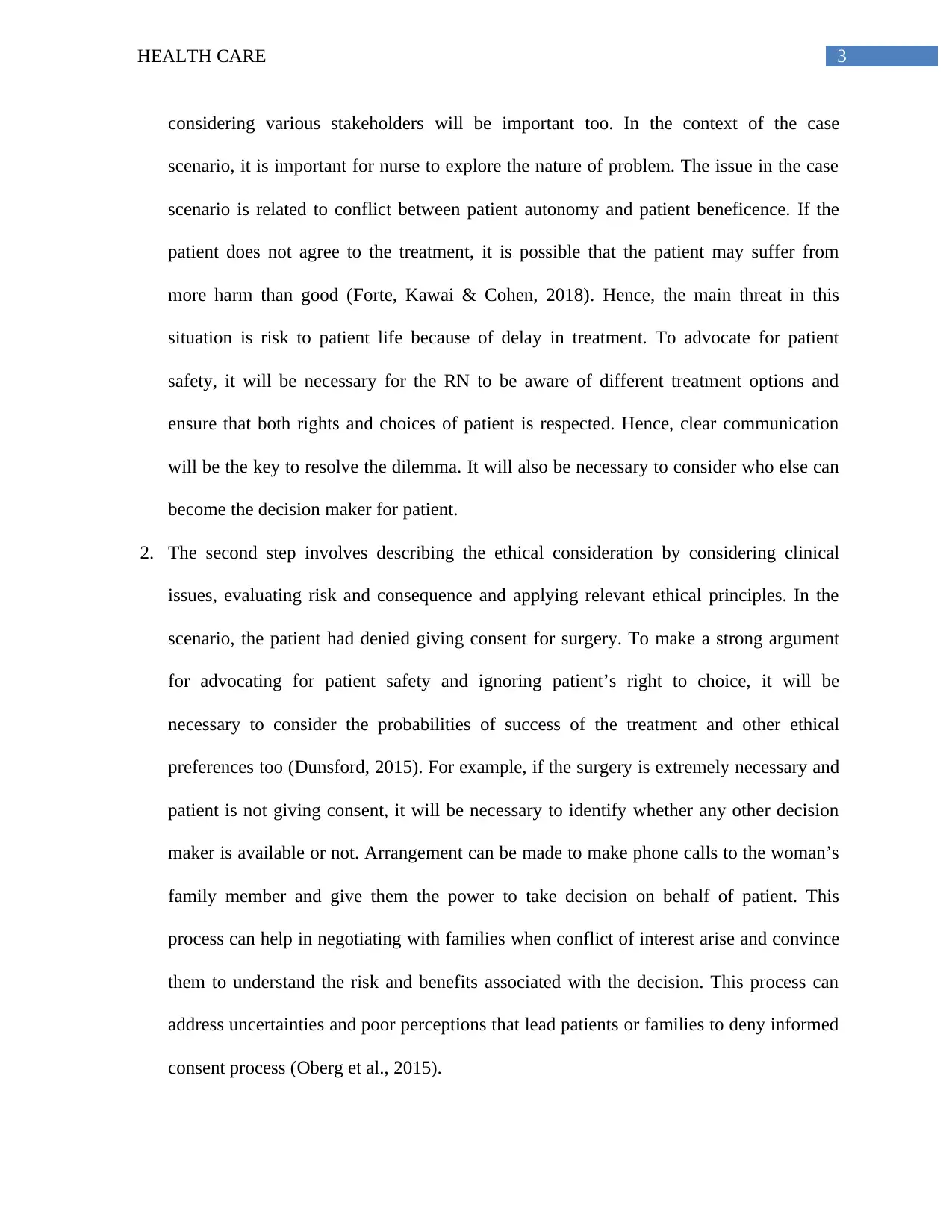
3HEALTH CARE
considering various stakeholders will be important too. In the context of the case
scenario, it is important for nurse to explore the nature of problem. The issue in the case
scenario is related to conflict between patient autonomy and patient beneficence. If the
patient does not agree to the treatment, it is possible that the patient may suffer from
more harm than good (Forte, Kawai & Cohen, 2018). Hence, the main threat in this
situation is risk to patient life because of delay in treatment. To advocate for patient
safety, it will be necessary for the RN to be aware of different treatment options and
ensure that both rights and choices of patient is respected. Hence, clear communication
will be the key to resolve the dilemma. It will also be necessary to consider who else can
become the decision maker for patient.
2. The second step involves describing the ethical consideration by considering clinical
issues, evaluating risk and consequence and applying relevant ethical principles. In the
scenario, the patient had denied giving consent for surgery. To make a strong argument
for advocating for patient safety and ignoring patient’s right to choice, it will be
necessary to consider the probabilities of success of the treatment and other ethical
preferences too (Dunsford, 2015). For example, if the surgery is extremely necessary and
patient is not giving consent, it will be necessary to identify whether any other decision
maker is available or not. Arrangement can be made to make phone calls to the woman’s
family member and give them the power to take decision on behalf of patient. This
process can help in negotiating with families when conflict of interest arise and convince
them to understand the risk and benefits associated with the decision. This process can
address uncertainties and poor perceptions that lead patients or families to deny informed
consent process (Oberg et al., 2015).
considering various stakeholders will be important too. In the context of the case
scenario, it is important for nurse to explore the nature of problem. The issue in the case
scenario is related to conflict between patient autonomy and patient beneficence. If the
patient does not agree to the treatment, it is possible that the patient may suffer from
more harm than good (Forte, Kawai & Cohen, 2018). Hence, the main threat in this
situation is risk to patient life because of delay in treatment. To advocate for patient
safety, it will be necessary for the RN to be aware of different treatment options and
ensure that both rights and choices of patient is respected. Hence, clear communication
will be the key to resolve the dilemma. It will also be necessary to consider who else can
become the decision maker for patient.
2. The second step involves describing the ethical consideration by considering clinical
issues, evaluating risk and consequence and applying relevant ethical principles. In the
scenario, the patient had denied giving consent for surgery. To make a strong argument
for advocating for patient safety and ignoring patient’s right to choice, it will be
necessary to consider the probabilities of success of the treatment and other ethical
preferences too (Dunsford, 2015). For example, if the surgery is extremely necessary and
patient is not giving consent, it will be necessary to identify whether any other decision
maker is available or not. Arrangement can be made to make phone calls to the woman’s
family member and give them the power to take decision on behalf of patient. This
process can help in negotiating with families when conflict of interest arise and convince
them to understand the risk and benefits associated with the decision. This process can
address uncertainties and poor perceptions that lead patients or families to deny informed
consent process (Oberg et al., 2015).
Secure Best Marks with AI Grader
Need help grading? Try our AI Grader for instant feedback on your assignments.
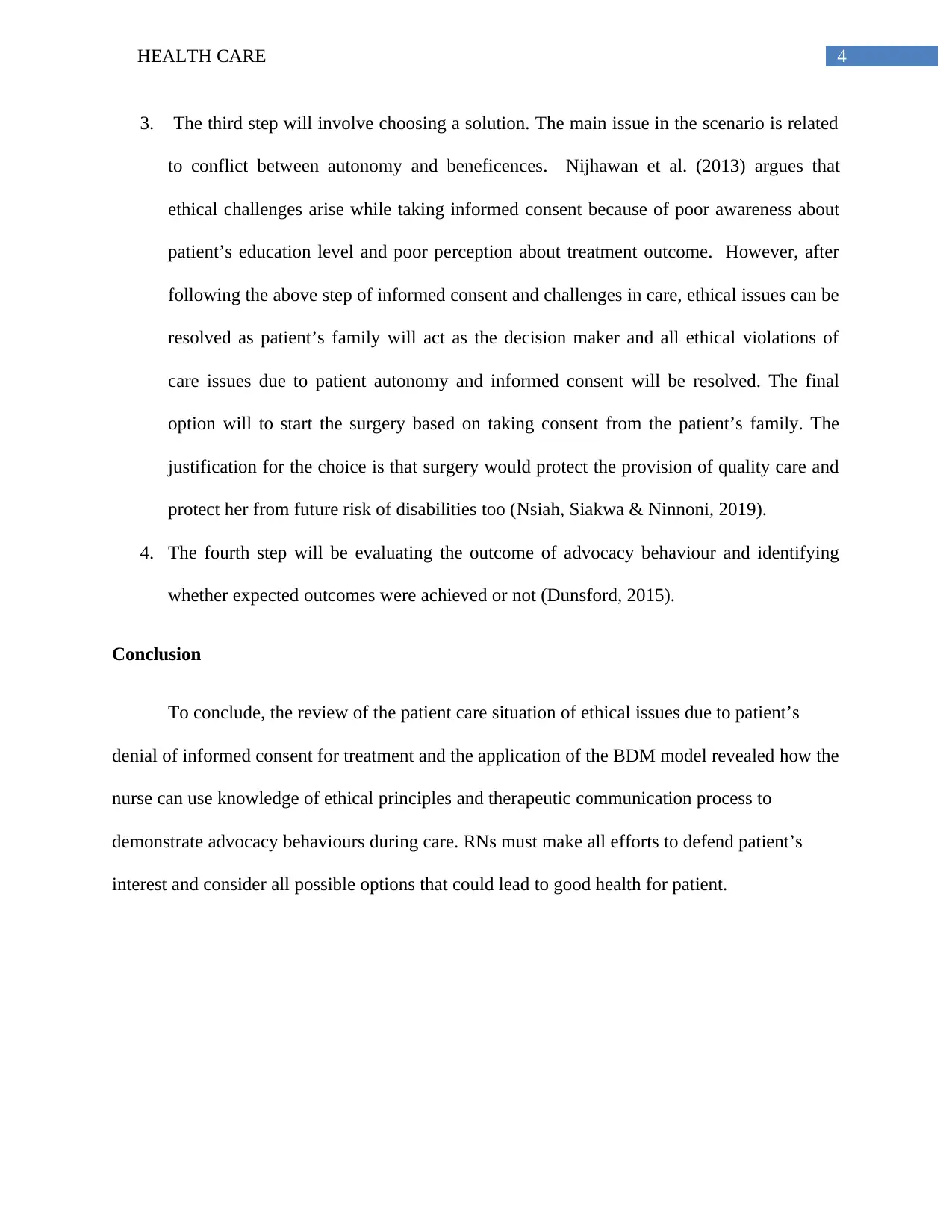
4HEALTH CARE
3. The third step will involve choosing a solution. The main issue in the scenario is related
to conflict between autonomy and beneficences. Nijhawan et al. (2013) argues that
ethical challenges arise while taking informed consent because of poor awareness about
patient’s education level and poor perception about treatment outcome. However, after
following the above step of informed consent and challenges in care, ethical issues can be
resolved as patient’s family will act as the decision maker and all ethical violations of
care issues due to patient autonomy and informed consent will be resolved. The final
option will to start the surgery based on taking consent from the patient’s family. The
justification for the choice is that surgery would protect the provision of quality care and
protect her from future risk of disabilities too (Nsiah, Siakwa & Ninnoni, 2019).
4. The fourth step will be evaluating the outcome of advocacy behaviour and identifying
whether expected outcomes were achieved or not (Dunsford, 2015).
Conclusion
To conclude, the review of the patient care situation of ethical issues due to patient’s
denial of informed consent for treatment and the application of the BDM model revealed how the
nurse can use knowledge of ethical principles and therapeutic communication process to
demonstrate advocacy behaviours during care. RNs must make all efforts to defend patient’s
interest and consider all possible options that could lead to good health for patient.
3. The third step will involve choosing a solution. The main issue in the scenario is related
to conflict between autonomy and beneficences. Nijhawan et al. (2013) argues that
ethical challenges arise while taking informed consent because of poor awareness about
patient’s education level and poor perception about treatment outcome. However, after
following the above step of informed consent and challenges in care, ethical issues can be
resolved as patient’s family will act as the decision maker and all ethical violations of
care issues due to patient autonomy and informed consent will be resolved. The final
option will to start the surgery based on taking consent from the patient’s family. The
justification for the choice is that surgery would protect the provision of quality care and
protect her from future risk of disabilities too (Nsiah, Siakwa & Ninnoni, 2019).
4. The fourth step will be evaluating the outcome of advocacy behaviour and identifying
whether expected outcomes were achieved or not (Dunsford, 2015).
Conclusion
To conclude, the review of the patient care situation of ethical issues due to patient’s
denial of informed consent for treatment and the application of the BDM model revealed how the
nurse can use knowledge of ethical principles and therapeutic communication process to
demonstrate advocacy behaviours during care. RNs must make all efforts to defend patient’s
interest and consider all possible options that could lead to good health for patient.
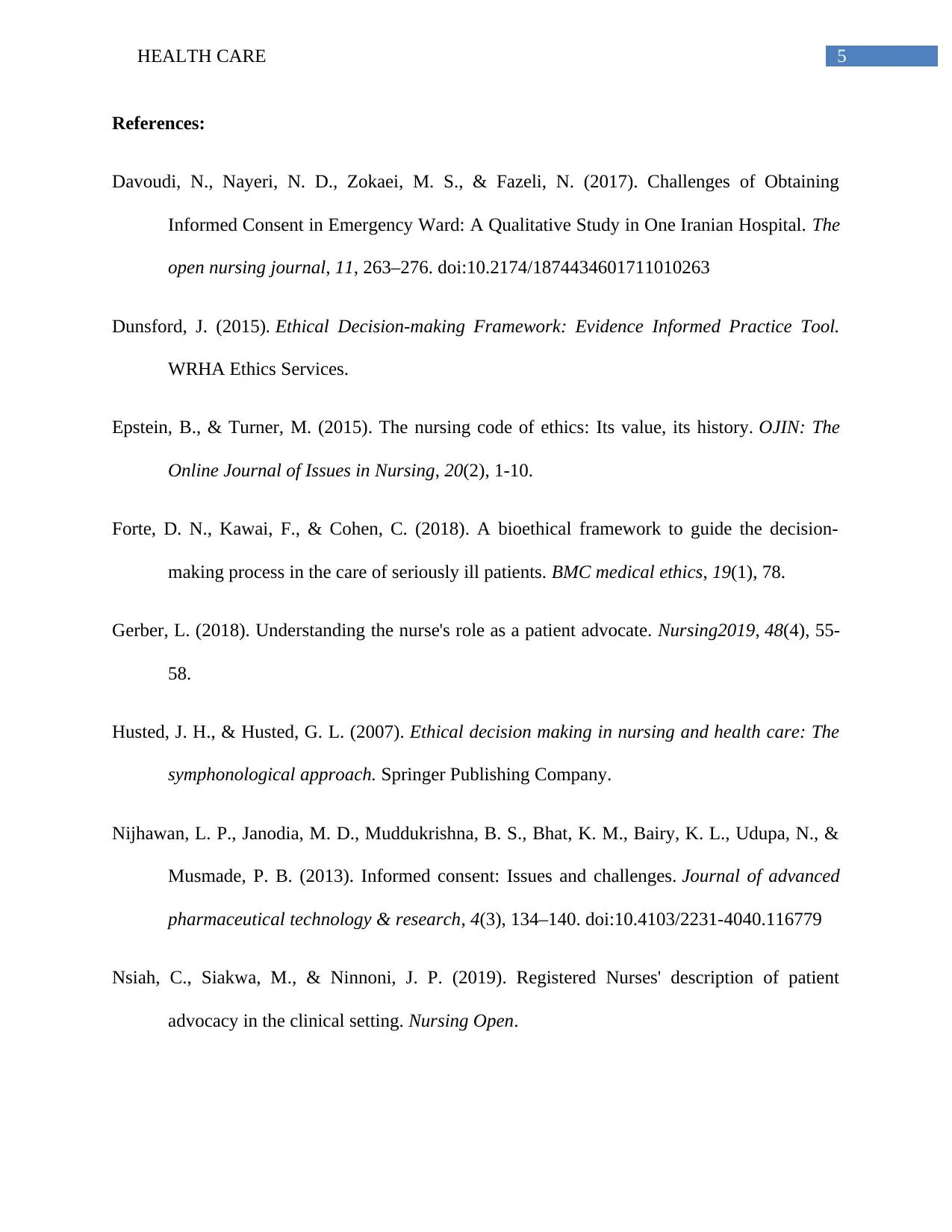
5HEALTH CARE
References:
Davoudi, N., Nayeri, N. D., Zokaei, M. S., & Fazeli, N. (2017). Challenges of Obtaining
Informed Consent in Emergency Ward: A Qualitative Study in One Iranian Hospital. The
open nursing journal, 11, 263–276. doi:10.2174/1874434601711010263
Dunsford, J. (2015). Ethical Decision-making Framework: Evidence Informed Practice Tool.
WRHA Ethics Services.
Epstein, B., & Turner, M. (2015). The nursing code of ethics: Its value, its history. OJIN: The
Online Journal of Issues in Nursing, 20(2), 1-10.
Forte, D. N., Kawai, F., & Cohen, C. (2018). A bioethical framework to guide the decision-
making process in the care of seriously ill patients. BMC medical ethics, 19(1), 78.
Gerber, L. (2018). Understanding the nurse's role as a patient advocate. Nursing2019, 48(4), 55-
58.
Husted, J. H., & Husted, G. L. (2007). Ethical decision making in nursing and health care: The
symphonological approach. Springer Publishing Company.
Nijhawan, L. P., Janodia, M. D., Muddukrishna, B. S., Bhat, K. M., Bairy, K. L., Udupa, N., &
Musmade, P. B. (2013). Informed consent: Issues and challenges. Journal of advanced
pharmaceutical technology & research, 4(3), 134–140. doi:10.4103/2231-4040.116779
Nsiah, C., Siakwa, M., & Ninnoni, J. P. (2019). Registered Nurses' description of patient
advocacy in the clinical setting. Nursing Open.
References:
Davoudi, N., Nayeri, N. D., Zokaei, M. S., & Fazeli, N. (2017). Challenges of Obtaining
Informed Consent in Emergency Ward: A Qualitative Study in One Iranian Hospital. The
open nursing journal, 11, 263–276. doi:10.2174/1874434601711010263
Dunsford, J. (2015). Ethical Decision-making Framework: Evidence Informed Practice Tool.
WRHA Ethics Services.
Epstein, B., & Turner, M. (2015). The nursing code of ethics: Its value, its history. OJIN: The
Online Journal of Issues in Nursing, 20(2), 1-10.
Forte, D. N., Kawai, F., & Cohen, C. (2018). A bioethical framework to guide the decision-
making process in the care of seriously ill patients. BMC medical ethics, 19(1), 78.
Gerber, L. (2018). Understanding the nurse's role as a patient advocate. Nursing2019, 48(4), 55-
58.
Husted, J. H., & Husted, G. L. (2007). Ethical decision making in nursing and health care: The
symphonological approach. Springer Publishing Company.
Nijhawan, L. P., Janodia, M. D., Muddukrishna, B. S., Bhat, K. M., Bairy, K. L., Udupa, N., &
Musmade, P. B. (2013). Informed consent: Issues and challenges. Journal of advanced
pharmaceutical technology & research, 4(3), 134–140. doi:10.4103/2231-4040.116779
Nsiah, C., Siakwa, M., & Ninnoni, J. P. (2019). Registered Nurses' description of patient
advocacy in the clinical setting. Nursing Open.
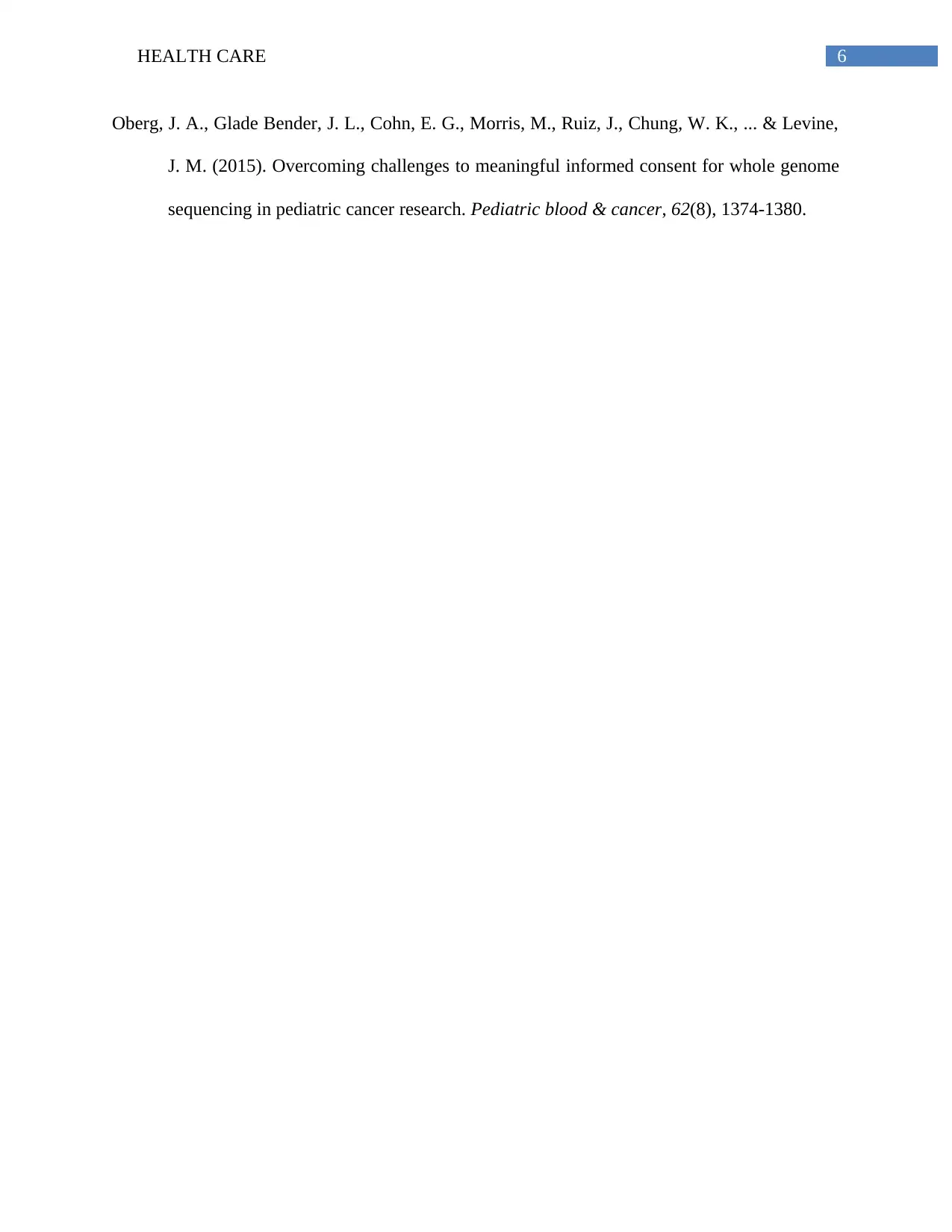
6HEALTH CARE
Oberg, J. A., Glade Bender, J. L., Cohn, E. G., Morris, M., Ruiz, J., Chung, W. K., ... & Levine,
J. M. (2015). Overcoming challenges to meaningful informed consent for whole genome
sequencing in pediatric cancer research. Pediatric blood & cancer, 62(8), 1374-1380.
Oberg, J. A., Glade Bender, J. L., Cohn, E. G., Morris, M., Ruiz, J., Chung, W. K., ... & Levine,
J. M. (2015). Overcoming challenges to meaningful informed consent for whole genome
sequencing in pediatric cancer research. Pediatric blood & cancer, 62(8), 1374-1380.
1 out of 7
Related Documents
Your All-in-One AI-Powered Toolkit for Academic Success.
+13062052269
info@desklib.com
Available 24*7 on WhatsApp / Email
![[object Object]](/_next/static/media/star-bottom.7253800d.svg)
Unlock your academic potential
© 2024 | Zucol Services PVT LTD | All rights reserved.





